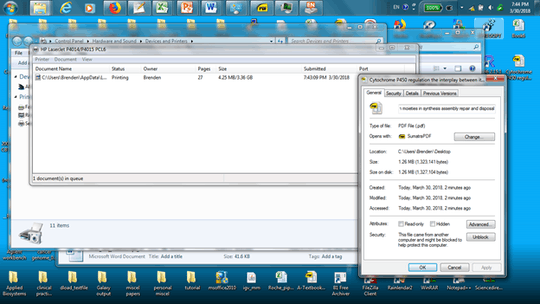On Windows, what data (format) goes to the printer almost never is the same as the document format you create and edit or receive from someone.
(An exception may be an XPS document viewed in an XPS viewer being sent to an XPS-capable printer...)
The document format may be Excel/XLS(X), Word/DOC(X), PowerPoint/PPT(X), PDF, HTML, EPUB, whatever. No printer understands these formats. A printer requires some specific format(s) to be able to consume it and print it on paper.
The data transfered to the print device (and before transfer being spooled in a local folder) is different: On Windows the locally spooled file format is EMF ('Enhanced Meta File') or (O)XPS ('(Open) XML Paper Specification'). But these are are also not suitable for a printer. Also, it is not the original file which gets sent to the printer and then is no longer on your PC: it's a copy of the file, and that copy needs to be converted to suit the printer. It is the job of the Printer Driver to accomplish this conversion:
- a PostScript printer wants PostScript
- a PCL printer wants PCL
- an ESC/P printer wants ESCP
- an RCPS printer wants RPCS
- a raster printer wants raster data (many possible variants)
So some printer drivers will convert all pages to hi-res raster data, which takes a lot of bytes. And this is what you observe as the "increase" of file size, but mis-interpreted it: because your original document is still un-changed (in format as well as in file size).

Clearly something else is going on. Your PDF did not increase in size to 3.23GB. But there is no way of knowing what the real situation entails based on the limited information you've provided. – n8te – 2018-03-30T23:22:07.903
@n8te, not sure what specific info would be helpful. – B Chen – 2018-03-30T23:25:03.137
If nothing else, a screenshot of where you're seeing that it says the PDF is now 3.23GB. – n8te – 2018-03-30T23:25:48.843
8The PDF file size hasn't changed ... the larger window with 4.25/3.36 gb is the printer spool file. The amount of data that gets sent to a printer has nothing whatever to do with the size of the file being printed and is temporary in any case. Short version: don't worry about it. – Steve Rindsberg – 2018-03-31T00:17:19.880
To amplify what @SteveRindsberg has said, depending on the document’s format and the printer’s capabilities, it is most likely that the PDF was rasterized by the print driver to actually print things out. Remember, a PDF is basically a postscript file which is basically a vector document which is just a pile of calculations telling the screen what to render. If you are printing to a printer without native postscript capabilities, the contents of the document need to be rasterized somewhere somehow and that can instantly balloon up the actual size of the file that gets sent to the printer. – JakeGould – 2018-04-01T04:19:13.737
You don't print "files", is the key point. – Lightness Races with Monica – 2018-04-01T12:40:30.767